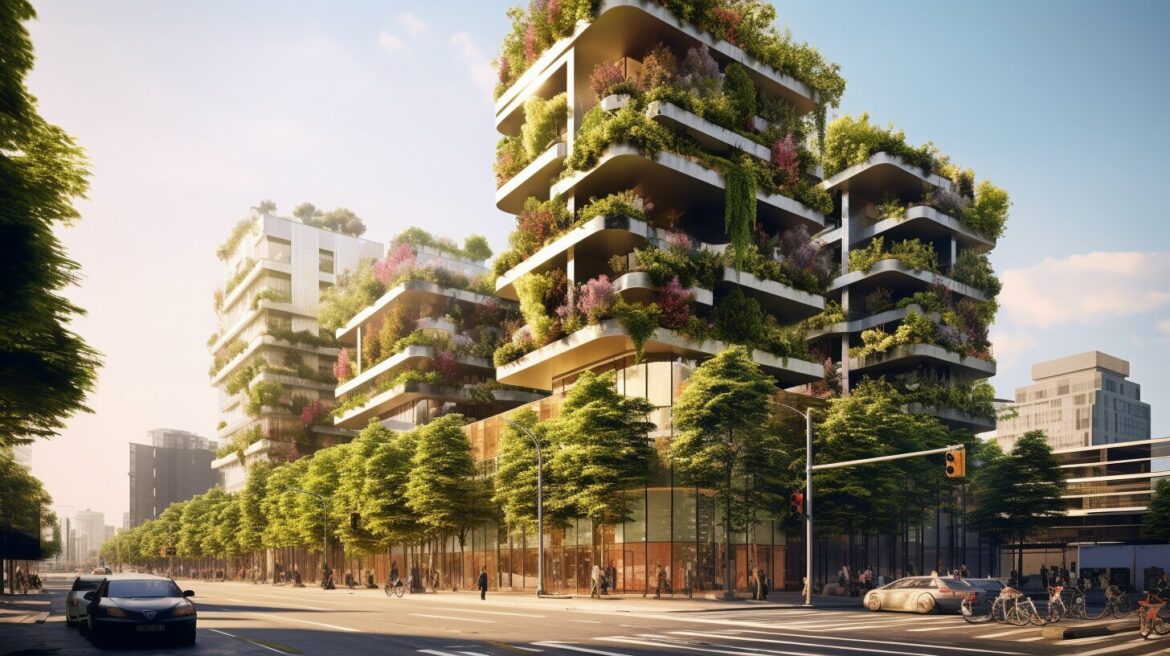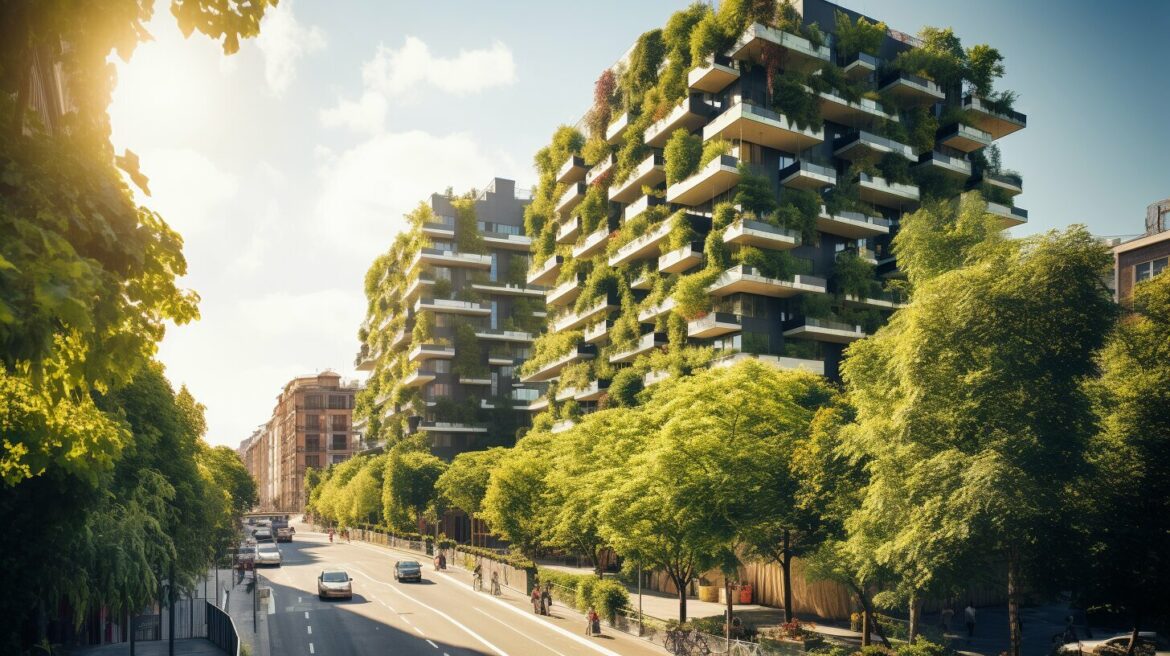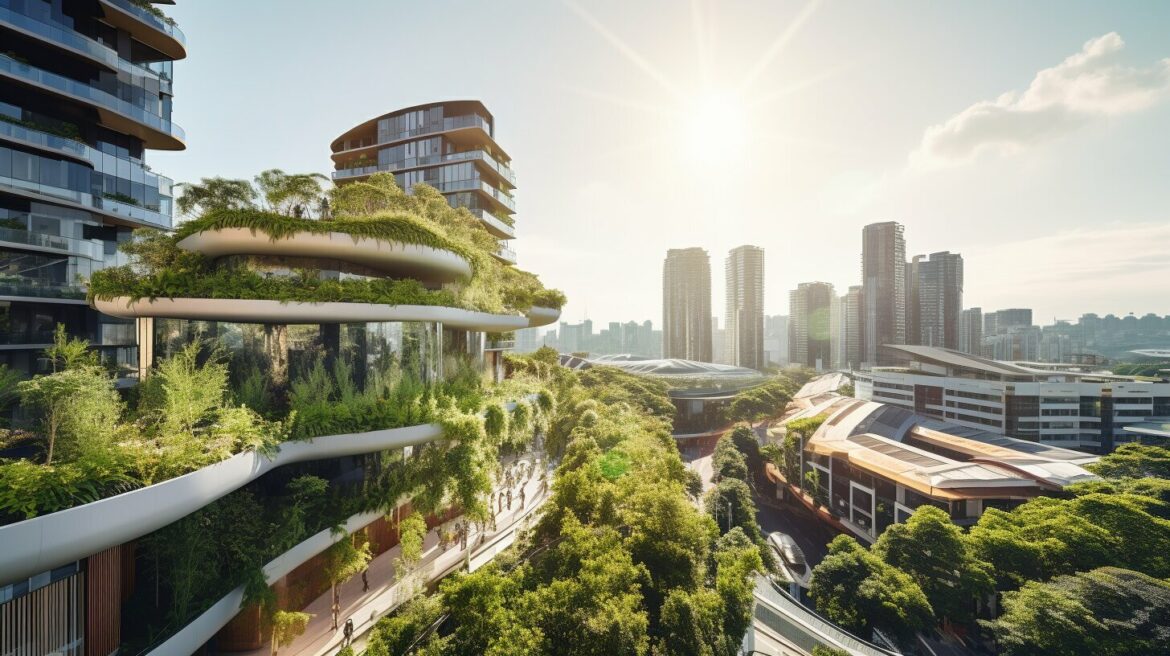Biodiversity Is Good For Business while also being a necessity now for the times we are living in
We urgently need to adopt nature positive solutions but it is important to understand that biodiversity is not only to protect the environment, but it can also attract customers and boost profits. Plus it is central to our health. In this feature, we will explore why biodiversity is beneficial for businesses in the built environment and highlight the advantages of promoting biodiversity initiatives.
So, why is biodiversity good for business in the built environment? Firstly, promoting biodiversity is essential for achieving sustainability. By encouraging the presence of a variety of plant and animal species, businesses can help to maintain the delicate balance of the local ecosystem and reduce their impact on the environment. Secondly, businesses that promote biodiversity initiatives can differentiate themselves from competitors and attract customers who value sustainability. Finally, investing in biodiversity can also provide long-term economic benefits, such as cost savings and increased profits.
The Importance of Biodiversity in the Built Environment
Biodiversity, or the variety of life on Earth, is crucial for supporting the natural systems that sustain life as we know it. In the built environment, biodiversity plays an equally important role in promoting sustainability, both economically and environmentally.
One of the key economic benefits of biodiversity is its ability to attract customers and boost profits. By promoting biodiversity in the built environment, businesses can create visually appealing spaces that are more inviting to customers. This can result in increased foot traffic, higher sales revenue, and a better overall customer experience.
But biodiversity also has important environmental benefits. By incorporating green infrastructure into buildings and landscapes, businesses can help to mitigate the impacts of climate change, such as flooding and heat waves. Additionally, biodiverse environments support a healthy ecosystem, providing habitat for a variety of plant and animal species.
Why Biodiversity is Good for Business in the Built Environment
Biodiversity also has long-term economic benefits. Investing in biodiversity initiatives can lead to a significant return on investment, as well as increased brand reputation and customer loyalty. By implementing sustainable practices and incorporating nature-based solutions, businesses can reduce costs and increase profitability.
To promote biodiversity in the built environment, businesses can implement a variety of strategies. These might include using native plant species, creating green roofs and walls, and restoring natural habitats. By doing so, businesses can not only improve the environment, but also create healthier and more enjoyable spaces for employees and customers alike.
Overall, biodiversity is essential for promoting sustainability in the built environment. By investing in biodiversity initiatives, businesses can enjoy a range of economic and environmental benefits, while also doing their part to support the health of our planet.

Biodiversity as an Investment
Investing in biodiversity initiatives is a valuable and sustainable investment for businesses. It not only provides long-term benefits for the environment but also has the potential for a high return on investment.
| Benefits of investing in biodiversity: |
| Economic benefits: Biodiversity initiatives can reduce operating costs and increase profits through cost-saving measures and increased efficiency. A study by Trucost found that businesses that implemented biodiversity measures had a 19 percent higher return on investment than those that did not. |
| Environmental benefits: By investing in biodiversity, businesses can promote sustainability and reduce their carbon footprint. This can lead to improved brand reputation and increased customer loyalty. |
One successful example of biodiversity as an investment is the Treepedia project by MIT Senseable City Lab. The project measures and analyzes the green canopy coverage of cities, providing data for cities to make informed decisions about investing in urban forests and green spaces. The project has received funding from various corporations, including Nokia and Verizon.
Investing in biodiversity may require a shift in mindset and business strategy. However, the long-term benefits for both the environment and a company’s bottom line make it a smart investment for businesses looking to promote sustainability and growth.

Promoting Biodiversity in the Built Environment
Biodiversity is not just a buzzword; it is an essential component of sustainable business practices. Promoting biodiversity in the built environment can enhance the aesthetic appeal of the infrastructure and boost the well-being of employees and customers.
One way businesses can promote biodiversity is by implementing sustainable practices that reduce the environmental impact of their operations. For example, using recycled materials, switching to more energy-efficient appliances, and reducing water consumption can significantly improve the ecological footprint of the infrastructure.
| Benefits of Sustainable Practices: |
| Cost Savings |
| Eco-Friendly Reputation |
| Stakeholder Engagement |
Another effective way of promoting biodiversity is by incorporating green infrastructure into the built environment. Green infrastructure, such as green roofs, living walls, and urban forests, can help mitigate the impacts of climate change by reducing urban heat island effect and enhancing air quality.

Promoting biodiversity can also help businesses attract customers who are environmentally conscious. Customers are increasingly aware of the impact of their consumption patterns on the environment, and they want to support businesses that prioritize sustainability.
Moreover, promoting biodiversity can contribute to a healthier and more productive working environment. Studies have shown that employees working in green spaces report lower levels of stress and higher levels of job satisfaction.
In conclusion, promoting biodiversity is an essential component of sustainable business practices in the built environment. Implementing sustainable practices, incorporating green infrastructure, and appealing to environmentally conscious customers are just some of the ways businesses can promote biodiversity and enjoy the associated benefits.
The Benefits of Biodiversity for Businesses
By promoting and investing in biodiversity, businesses can enjoy a wide range of benefits that go beyond environmental protection. Let’s take a closer look at some of the business benefits of biodiversity.
Enhanced Brand Reputation
One of the most significant benefits of promoting biodiversity is the positive impact on a business’s brand reputation. Consumers are increasingly conscious of environmental issues and are more likely to support businesses that demonstrate a commitment to sustainability. By integrating biodiversity initiatives into their operations, businesses can build a reputation as responsible corporate citizens and attract a loyal customer base.
Attract More Customers
In addition to enhancing brand reputation, promoting biodiversity can also attract new customers to a business. Studies have shown that consumers are more likely to purchase products or services from companies that prioritize sustainability and environmentally friendly practices. By promoting biodiversity, businesses can tap into this growing market and increase their customer base.
Foster Customer Loyalty
Biodiversity initiatives can also help businesses foster customer loyalty. Customers who perceive a business as environmentally responsible are more likely to continue using its products or services and recommend them to others. By promoting biodiversity, businesses can create deeper connections with their customers and build long-term relationships.

Increased Innovation and Creativity
Biodiversity initiatives can also lead to increased innovation and creativity within a business. By promoting sustainable practices, businesses can inspire employees to think creatively about new solutions and products that reduce their environmental footprint. This can lead to new revenue streams and increased profitability in the long run.
Cost Savings
Finally, promoting biodiversity can also result in significant cost savings for businesses. By implementing green technologies and nature-based solutions, businesses can reduce energy consumption, waste, and other operational costs. This can result in improved profitability and a more sustainable business model.
The benefits of biodiversity for businesses are clear. By promoting sustainable practices and investing in biodiversity initiatives, businesses can enhance their brand reputation, attract more customers, foster customer loyalty, increase innovation and creativity, and save costs. These benefits make biodiversity a valuable investment for any business operating in the built environment.
Nature-Based Solutions as Profitable Strategies
Investing in nature-based solutions can have a significant impact on a business’s profitability. By adopting green technologies and sustainable practices, businesses can reduce costs, increase efficiency, and attract environmentally conscious customers.
One example of a nature-based solution is green infrastructure, which involves using natural features like trees, vegetation, and water systems to manage stormwater runoff and improve air quality. By incorporating green infrastructure into building designs, businesses can significantly reduce energy costs and create a more pleasant environment for customers and employees alike.
Another example is the use of renewable energy sources like solar and wind power. By relying on these clean energy sources, businesses can reduce their carbon footprint and save money on energy costs in the long run.
Studies have shown that businesses that embrace sustainability practices see significant financial benefits. For example, a report from the Global Commission on the Economy and Climate found that businesses implementing low-carbon initiatives can see a return on investment of up to 30% within three years.
By investing in nature-based solutions, businesses can not only benefit financially, but also contribute to a healthier planet and a more sustainable future for all.

Biodiversity and Health Benefits
Not only is biodiversity good for business, but it also has positive effects on employee health and well-being. Nature-based solutions, such as incorporating greenery in the workplace, have been shown to improve physical health and reduce stress levels.
Studies have found that exposure to nature can lower blood pressure and heart rate, reduce muscle tension, and improve mood. Employees who have access to green spaces or plants in the workplace report lower stress levels and greater job satisfaction.
Furthermore, with the rise of remote work due to COVID-19, incorporating nature-based solutions in the home workspace can also have positive effects on employee health and well-being.

Creating a healthy and nurturing work environment can also boost productivity and reduce sick days, resulting in cost savings for the business.
Investing in biodiversity initiatives not only benefits the environment and the bottom line, but it also has a positive impact on the people within the built environment.
Case Studies: Successful Biodiversity Initiatives in the Built Environment
Real-life examples are key to understanding how biodiversity can benefit businesses. Here are some success stories that demonstrate the positive impact of promoting biodiversity in the built environment:
| Company |
Initiative |
Outcome |
| Skanska |
Incorporating green roofs and walls in buildings |
Reduced energy consumption, improved air quality, and enhanced aesthetic appeal of buildings, leading to increased customer satisfaction and greater demand for properties. |
| M&S |
Implementing sustainable sourcing practices for products |
Improved brand reputation and loyalty, cost savings, and reduced environmental impact. |
| Kingspan Group |
Investing in renewable energy sources and energy-efficient technologies |
Significant cost savings, reduced carbon footprint, and improved corporate social responsibility (CSR) rating. |
These case studies show that promoting biodiversity can have a range of benefits, from improving customer satisfaction to reducing costs and enhancing brand reputation. By implementing sustainable practices and incorporating nature-based solutions, businesses can create a healthier and more resilient built environment while also boosting their bottom line.

Overcoming Challenges in Promoting Biodiversity
While promoting biodiversity in the built environment has numerous benefits, it is not without its challenges. Challenges that businesses may face include lack of stakeholder engagement, insufficient funding, and limited policy support.
Stakeholder engagement is crucial for the success of biodiversity initiatives. It is important to involve all stakeholders, including employees, customers, and local communities, in the planning and implementation process. By doing so, businesses can ensure that their initiatives are aligned with the needs and expectations of the people they serve.
| Challenge |
Solution |
| Lack of stakeholder engagement |
Involving all stakeholders in the planning and implementation process |
| Insufficient funding |
Exploring diverse funding sources, such as grants or partnerships |
| Limited policy support |
Advocating for policies that promote and support biodiversity initiatives |
Another challenge businesses may encounter is insufficient funding. Biodiversity initiatives require resources, and often, businesses may not have adequate funds to invest in them. Exploring diverse funding sources, such as grants or partnerships, can help overcome this challenge.
Lastly, limited policy support can also be a challenge. Policies that promote and support biodiversity initiatives can help create a conducive environment for businesses to invest in these initiatives. Advocating for such policies can help overcome this challenge.
Despite the challenges, promoting biodiversity in the built environment is a worthy and necessary endeavour. By addressing these challenges and implementing effective strategies, businesses can contribute to a sustainable future for all.

Future Trends: The Role of Biodiversity in Business Growth
As we move into the future, the role of biodiversity in business growth is becoming increasingly important. With sustainability practices becoming a key factor in consumer decision-making, businesses that prioritize biodiversity are more likely to attract and retain customers, ultimately leading to increased profits.
One of the key trends we are seeing is the integration of nature-based solutions into business operations. From green roofs to biophilic design, companies are finding innovative ways to incorporate biodiversity into their built environment. This not only enhances the aesthetic value of the working environment but also creates a healthier, more productive space for employees.
Another trend is the use of biodiversity as a marketing tool. By promoting their sustainability initiatives, businesses can enhance their brand reputation and attract a larger customer base. For example, companies that source their materials sustainably or support biodiversity preservation projects can differentiate themselves from their competitors and benefit from increased customer loyalty.
Furthermore, biodiversity is becoming an increasingly important component of policy and regulation. Governments are recognizing the value of biodiversity and are incentivizing businesses to invest in nature-based solutions. This means that businesses that prioritize biodiversity are likely to receive policy support and funding, further driving their growth and profitability.
Overall, the future of business growth lies in sustainability practices, and biodiversity plays a crucial role in this. By integrating nature-based solutions into their operations, businesses can attract customers, enhance their brand reputation, and benefit from policy support, ultimately driving long-term growth and profitability. You may enjoy How To Deliver Urban Nature Based Solutions

Biodiversity FAQs
Here are some frequently asked questions about biodiversity in the built environment:
- What is biodiversity?Biodiversity refers to the variety of plant and animal species and their genetic diversity, as well as the habitats and ecosystems in which they live.
- Why is biodiversity important?Biodiversity is essential for maintaining ecosystems, regulating the climate, and providing clean air and water. It also supports human well-being by providing food, medicine, and recreation opportunities.
- What is the role of businesses in promoting biodiversity?Businesses can play a key role in promoting biodiversity by implementing sustainable practices, incorporating green infrastructure, and engaging in conservation efforts. They can also benefit from the economic and reputational advantages of promoting biodiversity.
- What are some examples of green infrastructure?Green infrastructure includes features such as green roofs, living walls, rain gardens, and permeable pavements. These elements help to manage stormwater, provide habitat for wildlife, and reduce urban heat island effects.
- How can businesses measure the success of biodiversity initiatives?Some metrics for measuring the success of biodiversity initiatives include the number of species and habitats supported, improvements in air and water quality, and reductions in energy consumption and waste generation.

Hopefully, these answers have helped to clarify some of your questions about biodiversity in the built environment. If you have any further queries, feel free to do some more research or consult with experts in the field.
Conclusion
In conclusion, promoting biodiversity in the built environment can have a multitude of benefits for businesses. By investing in sustainable practices and incorporating green infrastructure, businesses can enhance their brand reputation, attract more customers and foster customer loyalty. This, in turn, can boost profits and lead to long-term growth.
Nature-based solutions such as green technologies also offer significant cost savings for businesses, making them a profitable strategy. Moreover, biodiversity initiatives can have a positive impact on employee well-being, reducing stress levels and creating a healthier working environment.
Businesses that have successfully implemented biodiversity initiatives in the built environment have experienced numerous positive outcomes, including increased revenue and reduced operating costs. While there may be challenges, such as stakeholder engagement and policy support, businesses that integrate sustainable practices into their strategies can stay competitive in the evolving landscape of the future.
The Importance of Biodiversity in Business
By prioritising biodiversity, businesses can make a valuable contribution to sustainability and create a positive impact on the environment. Biodiversity is a crucial aspect of the ecosystem and plays a significant role in the survival and quality of life of all species, including humans. Therefore, it is essential that businesses embrace biodiversity as an integral part of their operations, not only for their own growth and profitability but for the benefit of our planet.
You might like to check out some of these Top Cities For Biodiversity




























Post comments (0)